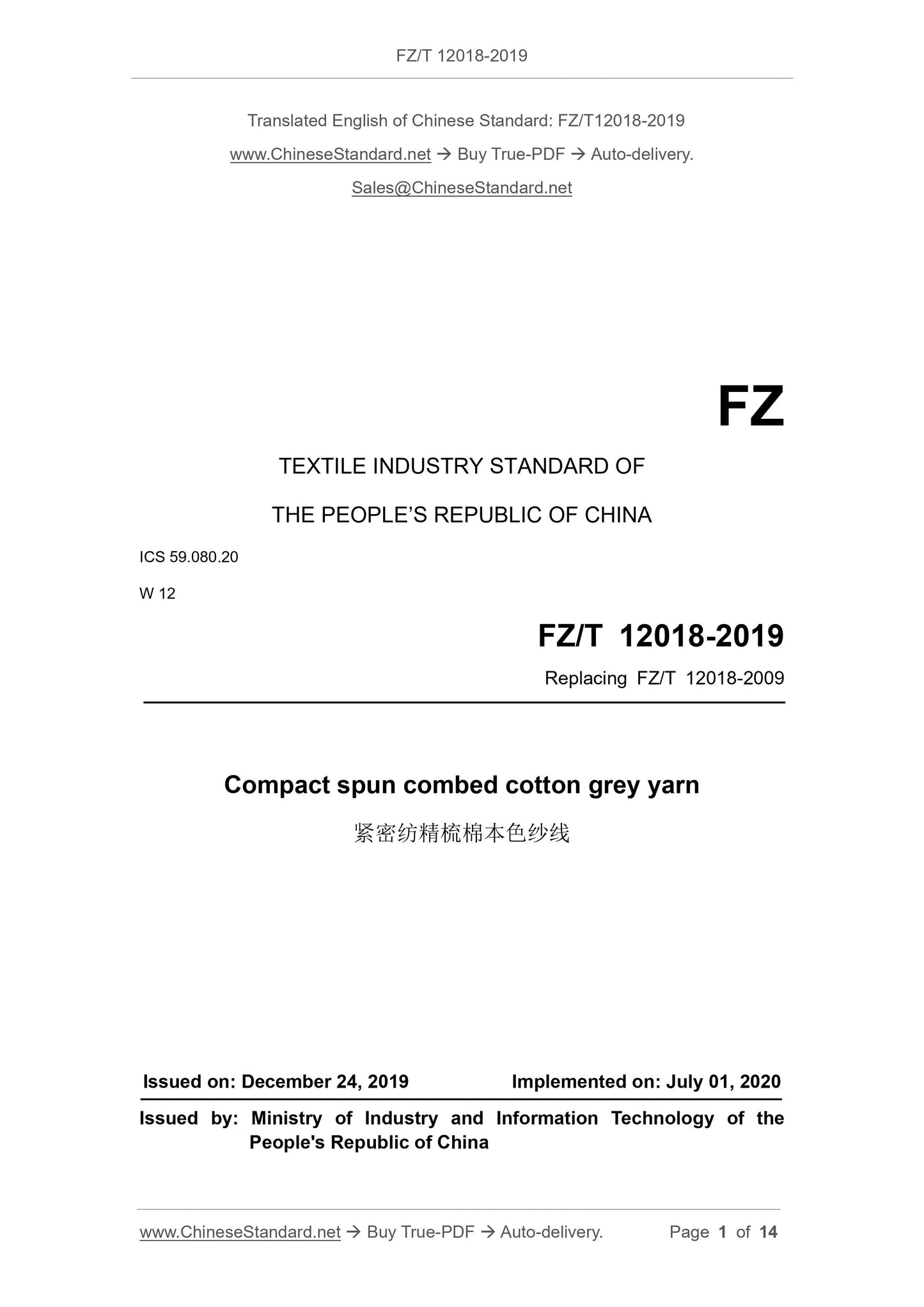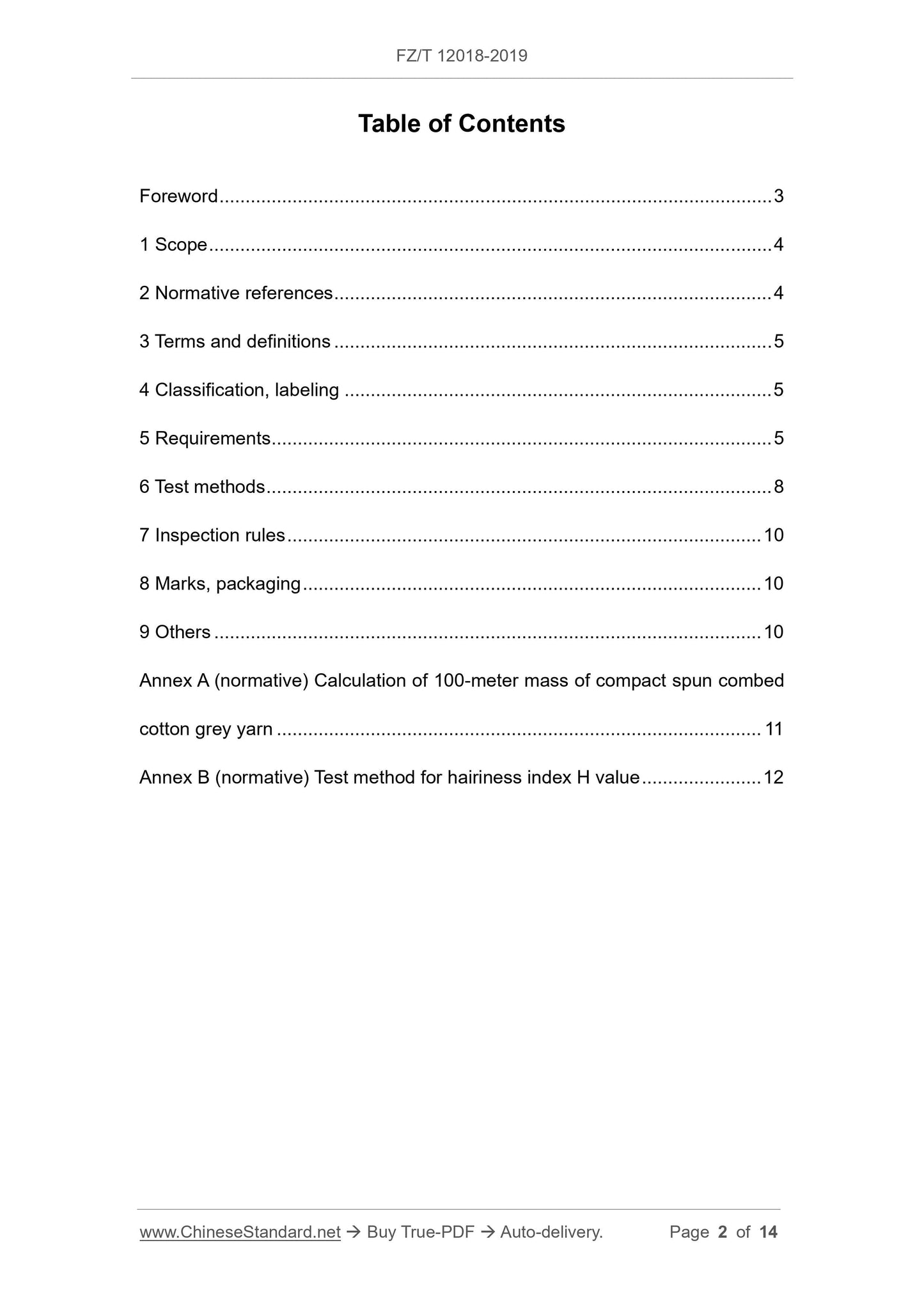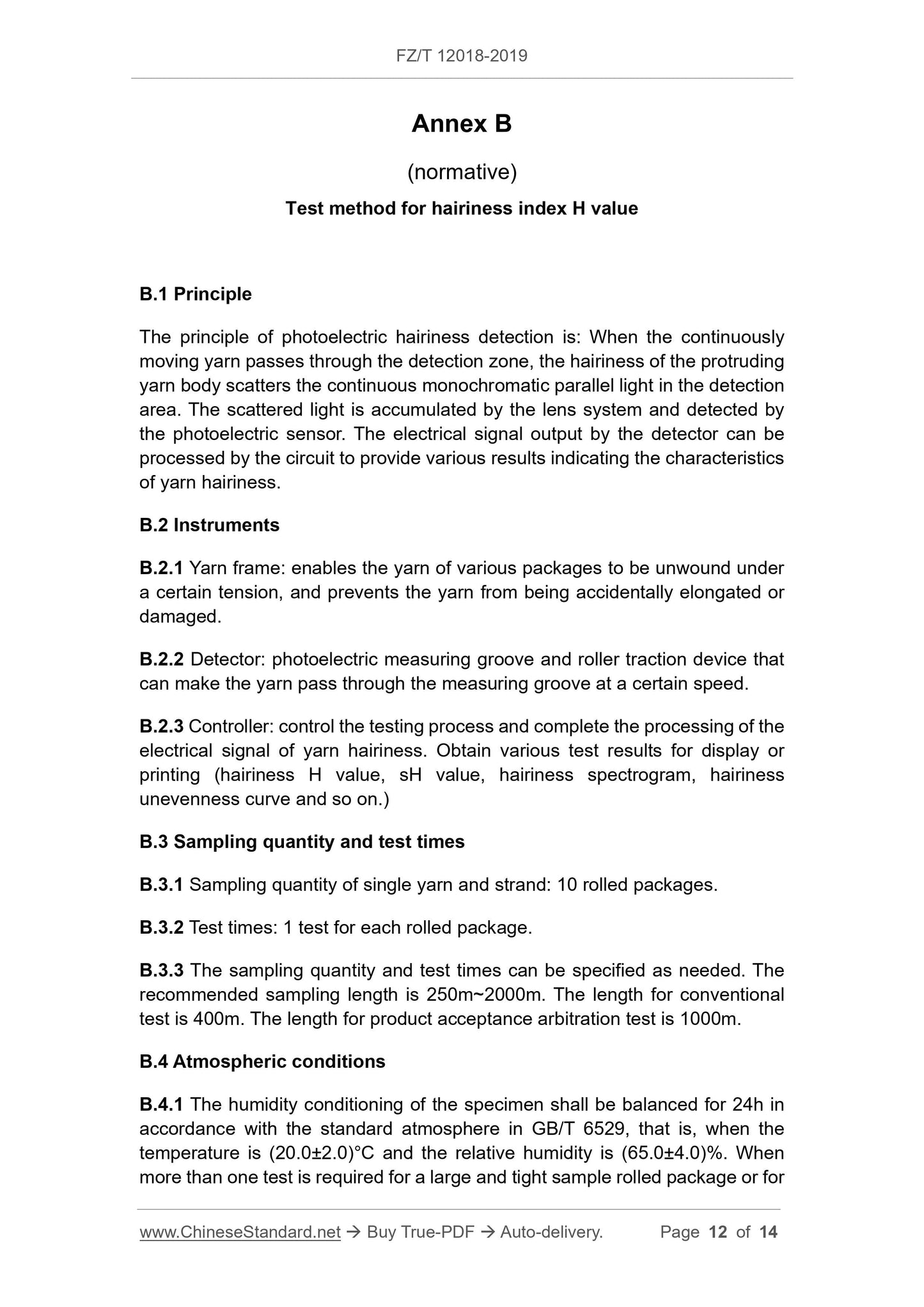1
/
of
5
PayPal, credit cards. Download editable-PDF and invoice in 1 second!
FZ/T 12018-2019 English PDF (FZT12018-2019)
FZ/T 12018-2019 English PDF (FZT12018-2019)
Regular price
$190.00 USD
Regular price
Sale price
$190.00 USD
Unit price
/
per
Shipping calculated at checkout.
Couldn't load pickup availability
Delivery: 3 seconds. Download true-PDF + Invoice.
Get QUOTATION in 1-minute: Click FZ/T 12018-2019
Historical versions: FZ/T 12018-2019
Preview True-PDF (Reload/Scroll if blank)
FZ/T 12018-2019: Compact spun combed cotton grey yarn
FZ/T 12018-2019
FZ
TEXTILE INDUSTRY STANDARD OF
THE PEOPLE’S REPUBLIC OF CHINA
ICS 59.080.20
W 12
Replacing FZ/T 12018-2009
Compact spun combed cotton grey yarn
紧密纺精梳棉本色纱线
ISSUED ON: DECEMBER 24, 2019
IMPLEMENTED ON: JULY 01, 2020
Issued by: Ministry of Industry and Information Technology of the
People's Republic of China
Table of Contents
Foreword ... 3
1 Scope ... 4
2 Normative references ... 4
3 Terms and definitions ... 5
4 Classification, labeling ... 5
5 Requirements ... 5
6 Test methods ... 8
7 Inspection rules ... 10
8 Marks, packaging ... 10
9 Others ... 10
Annex A (normative) Calculation of 100-meter mass of compact spun combed
cotton grey yarn ... 11
Annex B (normative) Test method for hairiness index H value ... 12
Compact spun combed cotton grey yarn
1 Scope
This Standard specifies the terms and definitions, classification, labeling,
requirements, test methods, inspection rules and marks, packaging for compact
spun combed cotton grey yarn.
This Standard is applicable to combed cotton grey yarn produced by compact
spinning technology.
2 Normative references
The following referenced documents are indispensable for the application of
this document. For dated references, only the edition cited applies. For undated
references, the latest edition of the referenced document (including any
amendments) applies.
GB/T 3292.1, Textiles - Unevenness of textile strands - Part 1: Capacitance
method
GB/T 3916, Textiles - Yarns from packages - Determination of single-end
breaking force and elongation at break
GB/T 4743-2009, Textiles - Yarn from packages - Determination of linear
density (mass per unit length) by the skein method
GB/T 5705, Textiles - Cotton textile products - Terminology
GB/T 6529, Textiles - Standard atmospheres for conditioning and testing
GB/T 8170, Rules of rounding off for numerical values and expression and
judgement of limiting values
FZ/T 01050, Textiles - Classifying and testing method of yarn faults -
Capacitance
FZ/T 01086, Test method for yarn hairness - Projection counting method
FZ/T 10007, Inspection rules for grey yarn of cotton, man-made fiber or their
blend
FZ/T 10008, Marking and packing of yarn spun with pure cotton, pure
chemical fibre or blend
3 Terms and definitions
For the purposes of this document, the terms and definitions defined in GB/T
5705 as well as the followings apply.
3.1 compact spun combed cotton grey yarn
the yarn that a fiber gathering device is added before the drafting part of the
ring spinning frame, and the combed cotton sliver fiber is gathered and spun by
airflow or mechanical means
4 Classification, labeling
4.1 The product specifications of compact spun combed cotton grey yarn are
classified according to different production processes and linear densities.
4.2 The production process and raw material code of compact spun combed
cotton grey yarn are indicated by English letters. CP is the code for compact
spinning. JC is the code for combed cotton.
4.3 When the compact spun combed cotton grey yarn is marked with a code,
the production process code and raw material code of the yarn shall be marked
before the line density.
Example 1: The compact spun combed cotton grey yarn with a linear density of
14.8tex shall be written as CP JC 14.8 tex.
Example 2: The compact spun combed cotton grey double-stranded thread with
a linear density of 14.8tex shall be written as CP JC 14.8tex × 2.
5 Requirements
5.1 Items
The technical requirements for compact spun combed cotton grey yarn (thread)
include 9 items: linear density deviation rate, linear density variation coefficient,
single yarn (thread) breaking strength, single yarn (thread) breaking strength
variation coefficient, evenness variation coefficient, kilometer thick section
(+50%), kilometer neps (+200%), 100,000-meter yarn defect, hairiness index H
value or 2mm hairiness index.
5.2 Grading regulations
Annex B
(normative)
Test method for hairiness index H value
B.1 Principle
The principle of photoelectric hairiness detection is: When the continuously
moving yarn passes through the detection zone, the hairiness of the protruding
yarn body scatters the continuous monochromatic parallel light in the detection
area. The scattered light is accumulated by the lens system and detected by
the photoelectric sensor. The electrical signal output by the detector can be
processed by the circuit to provide various results indicating the characteristics
of yarn hairiness.
B.2 Instruments
B.2.1 Yarn frame: enables the yarn of various packages to be unwound under
a certain tension, and prevents the yarn from being accidentally elongated or
damaged.
B.2.2 Detector: photoelectric measuring groove and roller traction device that
can make the yarn pass through the measuring groove at a certain speed.
B.2.3 Controller: control the testing process and complete the processing of the
electrical signal of yarn hairiness. Obtain various test results for display or
printing (hairiness H value, sH value, hairiness spectrogram, hairiness
unevenness curve and so on.)
B.3 Sampling quantity and test times
B.3.1 Sampling quantity of single yarn and strand: 10 rolled packages.
B.3.2 Test times: 1 test for each rolled package.
B.3.3 The sampling quantity and test times can be specified as needed. The
recommended sampling length is 250m~2000m. The length for conventional
test is 400m. The length for product acceptance arbitration test is 1000m.
B.4 Atmospheric conditions
B.4.1 The humidity conditioning of the specimen shall be balanced for 24h in
accordance with the standard atmosphere in GB/T 6529, that is, when the
temperature is (20.0±2.0)°C and the relative humidity is (65.0±4.0)%. When
more than one test is required for a large and tight sample rolled package or for
Get QUOTATION in 1-minute: Click FZ/T 12018-2019
Historical versions: FZ/T 12018-2019
Preview True-PDF (Reload/Scroll if blank)
FZ/T 12018-2019: Compact spun combed cotton grey yarn
FZ/T 12018-2019
FZ
TEXTILE INDUSTRY STANDARD OF
THE PEOPLE’S REPUBLIC OF CHINA
ICS 59.080.20
W 12
Replacing FZ/T 12018-2009
Compact spun combed cotton grey yarn
紧密纺精梳棉本色纱线
ISSUED ON: DECEMBER 24, 2019
IMPLEMENTED ON: JULY 01, 2020
Issued by: Ministry of Industry and Information Technology of the
People's Republic of China
Table of Contents
Foreword ... 3
1 Scope ... 4
2 Normative references ... 4
3 Terms and definitions ... 5
4 Classification, labeling ... 5
5 Requirements ... 5
6 Test methods ... 8
7 Inspection rules ... 10
8 Marks, packaging ... 10
9 Others ... 10
Annex A (normative) Calculation of 100-meter mass of compact spun combed
cotton grey yarn ... 11
Annex B (normative) Test method for hairiness index H value ... 12
Compact spun combed cotton grey yarn
1 Scope
This Standard specifies the terms and definitions, classification, labeling,
requirements, test methods, inspection rules and marks, packaging for compact
spun combed cotton grey yarn.
This Standard is applicable to combed cotton grey yarn produced by compact
spinning technology.
2 Normative references
The following referenced documents are indispensable for the application of
this document. For dated references, only the edition cited applies. For undated
references, the latest edition of the referenced document (including any
amendments) applies.
GB/T 3292.1, Textiles - Unevenness of textile strands - Part 1: Capacitance
method
GB/T 3916, Textiles - Yarns from packages - Determination of single-end
breaking force and elongation at break
GB/T 4743-2009, Textiles - Yarn from packages - Determination of linear
density (mass per unit length) by the skein method
GB/T 5705, Textiles - Cotton textile products - Terminology
GB/T 6529, Textiles - Standard atmospheres for conditioning and testing
GB/T 8170, Rules of rounding off for numerical values and expression and
judgement of limiting values
FZ/T 01050, Textiles - Classifying and testing method of yarn faults -
Capacitance
FZ/T 01086, Test method for yarn hairness - Projection counting method
FZ/T 10007, Inspection rules for grey yarn of cotton, man-made fiber or their
blend
FZ/T 10008, Marking and packing of yarn spun with pure cotton, pure
chemical fibre or blend
3 Terms and definitions
For the purposes of this document, the terms and definitions defined in GB/T
5705 as well as the followings apply.
3.1 compact spun combed cotton grey yarn
the yarn that a fiber gathering device is added before the drafting part of the
ring spinning frame, and the combed cotton sliver fiber is gathered and spun by
airflow or mechanical means
4 Classification, labeling
4.1 The product specifications of compact spun combed cotton grey yarn are
classified according to different production processes and linear densities.
4.2 The production process and raw material code of compact spun combed
cotton grey yarn are indicated by English letters. CP is the code for compact
spinning. JC is the code for combed cotton.
4.3 When the compact spun combed cotton grey yarn is marked with a code,
the production process code and raw material code of the yarn shall be marked
before the line density.
Example 1: The compact spun combed cotton grey yarn with a linear density of
14.8tex shall be written as CP JC 14.8 tex.
Example 2: The compact spun combed cotton grey double-stranded thread with
a linear density of 14.8tex shall be written as CP JC 14.8tex × 2.
5 Requirements
5.1 Items
The technical requirements for compact spun combed cotton grey yarn (thread)
include 9 items: linear density deviation rate, linear density variation coefficient,
single yarn (thread) breaking strength, single yarn (thread) breaking strength
variation coefficient, evenness variation coefficient, kilometer thick section
(+50%), kilometer neps (+200%), 100,000-meter yarn defect, hairiness index H
value or 2mm hairiness index.
5.2 Grading regulations
Annex B
(normative)
Test method for hairiness index H value
B.1 Principle
The principle of photoelectric hairiness detection is: When the continuously
moving yarn passes through the detection zone, the hairiness of the protruding
yarn body scatters the continuous monochromatic parallel light in the detection
area. The scattered light is accumulated by the lens system and detected by
the photoelectric sensor. The electrical signal output by the detector can be
processed by the circuit to provide various results indicating the characteristics
of yarn hairiness.
B.2 Instruments
B.2.1 Yarn frame: enables the yarn of various packages to be unwound under
a certain tension, and prevents the yarn from being accidentally elongated or
damaged.
B.2.2 Detector: photoelectric measuring groove and roller traction device that
can make the yarn pass through the measuring groove at a certain speed.
B.2.3 Controller: control the testing process and complete the processing of the
electrical signal of yarn hairiness. Obtain various test results for display or
printing (hairiness H value, sH value, hairiness spectrogram, hairiness
unevenness curve and so on.)
B.3 Sampling quantity and test times
B.3.1 Sampling quantity of single yarn and strand: 10 rolled packages.
B.3.2 Test times: 1 test for each rolled package.
B.3.3 The sampling quantity and test times can be specified as needed. The
recommended sampling length is 250m~2000m. The length for conventional
test is 400m. The length for product acceptance arbitration test is 1000m.
B.4 Atmospheric conditions
B.4.1 The humidity conditioning of the specimen shall be balanced for 24h in
accordance with the standard atmosphere in GB/T 6529, that is, when the
temperature is (20.0±2.0)°C and the relative humidity is (65.0±4.0)%. When
more than one test is required for a large and tight sample rolled package or for
Share










